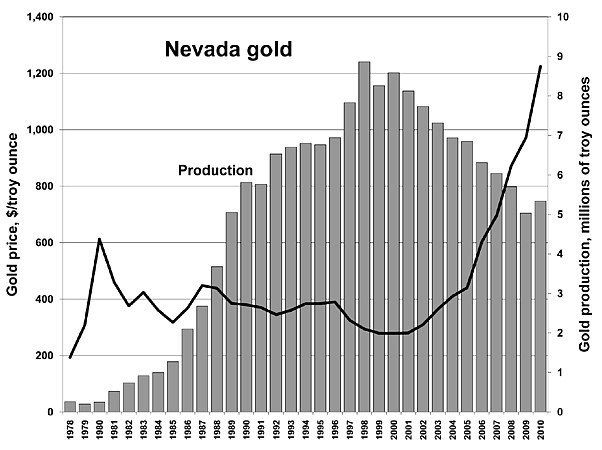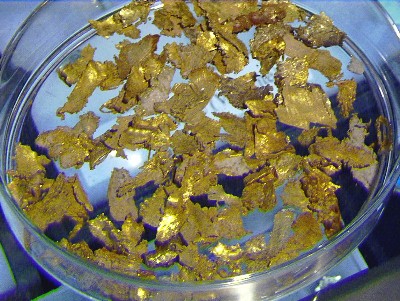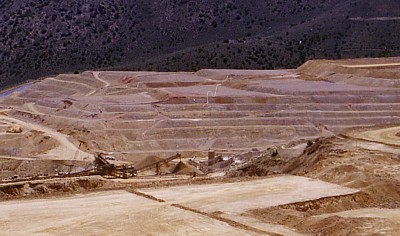|
The normal host rocks for
these unusual gold deposits are
thin-bedded silty or argillaceous, carbonaceous
limestone or
dolomites, commonly associated with carbonaceous shale. A lesser
percentage of the host rocks are intrusive rocks such as small stocks and
felsic dikes. The typical mineralogy of these gigantic mines includes:
Native gold (very fine grained),
pyrite,
realgar,
orpiment,
arsenopyrite,
cinnabar,
fluorite,
barite,
stibnite with
quartz,
calcite, carbonaceous organic matter. The deposits contain generally
less than 1 percent of fine-grained
sulfides. They often feature selective
replacement of carbonaceous carbonate rocks adjacent to and along high-angle
faults, or regional thrust faults or bedding
with silica replacing the carbonate
rocks with a jasperoid quartz material.
|
 |
. |
|
|
The Carlin trend continues to produce
millions of ounces of gold each year from a number of truly gigantic mines, but virtually
all the gold found in these locations is microscopic in size (typically a few microns in
diameter). While the ore grade at some locations in the mines is fairly high, no metal detector can detect
micron sized gold particles (and who would want to dig them if one did!). Even a gold pan
will not capture these tiny particles. However a standard fire assay will capture and
reveal them without any difficulty. Most of these ores are processed using
cyanide solutions in either vat leach or heap leach configurations. As far
as placer deposits, there are a few very small placer deposits near Carlin
at Lynn Creek and some other nearby drainages. These creeks were small producers, perhaps
10,000 ounces total for all the placer workings combined. Nuggets up to about an ounce
were found. These placers lie on the other side of a major thrust fault from the more
productive mines at Carlin. The geologists interpret the placers as being a leakage halo
in a less favorable rock type, showing the presence of much richer deposits which lie
below them, across the thrust fault in more favorable rock types. A very extensive report
with all you would ever want to know about Carlin type hard rock deposits can be
downloaded at: Gold Deposits of the Carlin Trend (NBMG Bulletin 111)
http://www.nbmg.unr.edu/dox/b111/b111.htm
There was also some placer gold mined out at Tuscarora, which is another area where there
are big open pit mines, but again most of the gold from the big mines in that area is
microscopic and not detectable. In any case, most Carlin type deposits in Nevada do not
have placers at all and produce only micron sized gold - great for cyanide leaching, but
no good for metal detectors. This is the real reason why our state produces very large
quantities of gold, but very little placer by comparison. While our state of
Nevada may lead the US in gold
production, the fact is that most of the state's gold is microscopic. Now even though Nevada does not
produce placer in proportion to the production of its huge sediment hosted deposits, the
state does still produce some nice placer gold. Most of the placer gold which is
found in Nevada with metal detectors comes from a geologically very different area, which lies
outside the Carlin Trend and is quite unlike the sediment hosted deposits. The most extensive placer area in Nevada is located in
the northern
part of the state in Pershing and Humboldt counties. |
While Nevada has a storied history of rich
gold and silver discoveries, One of the best example in recent decades comes
from the Sleeper Mine. This property is another example of a significant Nevada mine that produced
some very rich ore, but no placer gold is found in this part of Humboldt county. Here is a bit of
information about the famous Sleeper Mine, its discovery and mining history:
In the early 1980s, Amax, a mining company famous in the USA for the Climax Molybdenum
mine in Colorado, had rights on some old gold mining properties in Northern Nevada, and
were drilling them for bulk minable gold deposits. They had found some small
amount of low grade ore, perhaps suitable for open pit mining, and
were continuing to drill, looking for more ore - an amount sufficient to
justify the construction of a mining facility. They sent out a geologist and he completed
all the planned drill holes he was supposed to do in that round of work. It takes some weeks to process the
assays and get a report of the results, but nothing of great importance was found with the holes he had
just drilled (but he just
didn’t know that yet). There was some sort of delay, which prevented him from going
on to the next drill target property for a week or so. So, for the heck of it while he was
waiting, he put a drill hole into the playa, on an old lake bed, near the edge of the
hills where they had been drilling. There were no indications of anything of importance on
the surface, which was deeply covered in dry lake bed sediments. There was
nothing that outcropped to the surface in that area, so it was a totally
blind,
wildcat hole, based only on the intuition of the geologist. He selected the spot as it
seemed to be the likely intersection of two fault zones out on the playa.
Luck was with him and the core came out
filled with obvious rich visible gold threads suspended through the rock. The high grade
ore from this mine was extremely rich, and additional drilling showed more and more super
rich ore. The Sleeper became one of the richest open pit mines in Nevada - much of the ore
was close to an ounce per ton which is rather rich for a surface mine. Over its life, it
produced over one million ounces of gold.
No gold was found at Sleeper with a metal detector before the drilling was
done as the deposit was buried
beneath about 60 feet of barren lake bed clay and silt. No doubt a good detector could identify
some of the ore mined there, but 20 meters is more than just a bit too deep. Some folks have recovered a bit
of placer from some nearby mines in the hills to the east which have been
known since the 1880s, but the sleeper deposit itself was buried just too
deeply. The amounts of placer gold from the adjoining hills were quite
small. The Sleeper mine area is still being explored by various mining
companies for
additional rich deposits, but so far no additional important high grade
deposits have been found in the area, despite considerable exploration
efforts. Some lower grade material that may be economic at today's high
prices has been found in this extensive and ongoing exploration of the area. Ongoing Mining
and Exploration efforts in are covered by the
ICMJ Mining Journal magazine.
|



